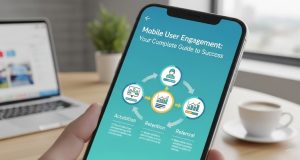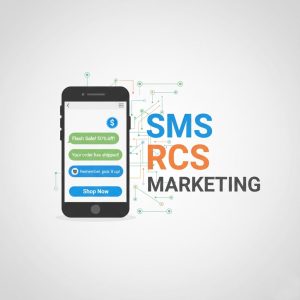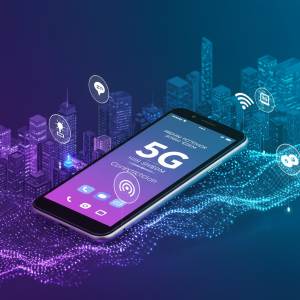Mobile Content Marketing: Your Complete Strategy Guide

Mobile devices have fundamentally changed how consumers interact with brands. Over 60% of all web traffic now comes from mobile devices, making mobile content marketing essential for business success. This comprehensive guide will walk you through everything you need to know to create effective mobile content strategies that engage your audience and drive results.
Understanding Mobile Content Marketing

Mobile content marketing focuses on creating and distributing valuable, relevant content specifically optimized for mobile devices. This approach recognizes that mobile users have different behaviors, preferences, and constraints compared to desktop users. Learn more about Mobile Marketing.
Mobile users typically seek quick, easily digestible information. They’re often multitasking, have shorter attention spans, and may be dealing with slower internet connections. Your content strategy must account for these factors to be effective.
The key difference between traditional and mobile content marketing lies in the user experience. Mobile screens are smaller, touch-based navigation is different, and loading speeds matter more than ever. Content that works perfectly on desktop may fail completely on mobile devices.
Key Mobile Content Marketing Strategies
Optimize for Mobile-First Design
Mobile-first design means creating content with mobile users as your primary audience, then scaling up for larger screens. This approach ensures your content works seamlessly across all devices.
Start by considering how your content will look on a smartphone screen. Use shorter paragraphs, larger fonts, and plenty of white space. Navigation should be thumb-friendly, with buttons and links appropriately sized for touch interaction.
Test your content on various mobile devices to ensure consistent performance. What looks great on an iPhone may not work as well on an Android tablet. Regular testing helps identify and fix issues before they impact user experience.
Create Bite-Sized Content
Mobile users prefer content they can consume quickly. Break long articles into shorter sections with descriptive headings. Use bullet points, numbered lists, and brief paragraphs to make information easier to scan.
Consider creating content series instead of single long pieces. A five-part series on marketing automation might perform better than one comprehensive guide. This approach also gives you more opportunities to engage with your audience over time.
Infographics work particularly well on mobile devices. They present complex information visually, making it easier to understand at a glance. Ensure your infographics are optimized for mobile viewing with readable text and clear visuals.
Focus on Visual Content
Visual content performs exceptionally well on mobile devices. Images, videos, and graphics capture attention quickly and convey information efficiently. They also break up text, making your content more visually appealing on small screens.
Videos are particularly powerful for mobile content marketing. Short-form videos under two minutes tend to perform best. Consider creating tutorial videos, behind-the-scenes content, or quick tips that provide immediate value to your audience.
When using images, optimize them for fast loading. Large image files can slow down your site, frustrating mobile users who expect quick access to information. Use compressed images without sacrificing quality.
Leverage Location-Based Marketing

Mobile devices provide unique opportunities for location-based marketing. Use geolocation data to deliver relevant, timely content based on where your audience is located.
Local businesses can create content that highlights nearby events, weather-related tips, or location-specific offers. Even national brands can benefit from location-based content by tailoring messages to different regions or time zones.
Consider creating location-specific landing pages or content sections. A restaurant chain might create different content for each city they serve, highlighting local partnerships or community involvement.
Content Formats That Work Best on Mobile
Interactive Content
Interactive content engages mobile users more effectively than static content. Polls, quizzes, surveys, and interactive infographics encourage participation and increase time spent with your brand.
Interactive content also provides valuable data about your audience preferences and behaviors. Use this information to refine your content strategy and create more targeted campaigns.
Keep interactive elements simple and intuitive. Complex interactions that work well on desktop may be frustrating on mobile devices. Test all interactive features across different devices and screen sizes.
Social Media Stories
Stories on platforms like Instagram, Facebook, and LinkedIn are designed specifically for mobile consumption. They’re full-screen, vertical, and disappear after 24 hours, creating urgency and encouraging immediate engagement.
Use stories to share behind-the-scenes content, quick tips, or time-sensitive offers. The temporary nature of stories makes them perfect for flash sales or limited-time promotions.
Story highlights allow you to save important stories permanently. Use highlights to organize content by topic, creating an easily accessible resource for your audience.
Live Content
Live streaming connects with mobile audiences in real-time. Whether it’s a product launch, Q&A session, or educational webinar, live content creates immediate engagement and builds community.
Mobile users can watch live streams anywhere, making this format particularly appealing for busy professionals or consumers on the go. Promote live sessions in advance to maximize attendance.
After live sessions end, repurpose the content into shorter clips or blog posts. This approach maximizes the value of your live content investment.
Optimizing Content for Mobile Devices
Page Speed Optimization
Mobile users expect fast-loading content. Pages that take longer than three seconds to load lose significant numbers of visitors. Optimize images, minimize code, and use content delivery networks to improve loading speeds.
Google’s mobile-first indexing means page speed directly impacts your search rankings. Faster sites rank higher in mobile search results, increasing your visibility to potential customers.
Use tools like Google PageSpeed Insights to identify speed issues and get specific recommendations for improvement. Regular monitoring helps maintain optimal performance as you add new content.
Mobile-Friendly Navigation
Navigation on mobile devices should be simple and intuitive. Use hamburger menus to save space, but ensure important links are easily accessible. Consider sticky navigation that remains visible as users scroll.
Implement breadcrumb navigation to help users understand their location within your site. This is particularly important for e-commerce sites with multiple product categories.
Search functionality becomes crucial on mobile devices where navigation space is limited. Include a prominent search bar to help users find specific content quickly.
Touch-Friendly Design
Design all interactive elements with touch navigation in mind. Buttons should be large enough to tap easily without accidentally hitting neighboring elements. The minimum recommended size is 44×44 pixels.
Leave adequate space between clickable elements. Cramped layouts lead to user frustration and accidental clicks. White space isn’t wasted space—it’s essential for good mobile user experience.
Consider thumb reach when placing important elements. The bottom of the screen is easiest to reach with thumbs, making it ideal for primary call-to-action buttons.
Measuring Mobile Content Marketing Success
Key Performance Indicators
Track metrics that specifically measure mobile performance. Mobile bounce rate, mobile conversion rate, and mobile session duration provide insights into how well your content serves mobile users.
Monitor mobile search rankings separately from desktop rankings. Mobile search results can differ significantly from desktop results, affecting your visibility to mobile users.
Use heat mapping tools to understand how mobile users interact with your content. This data reveals which sections capture attention and which are ignored, helping you optimize layout and design.
Analytics Tools
Google Analytics provides detailed mobile performance data. Set up custom segments to analyze mobile traffic separately from desktop traffic. This approach reveals mobile-specific trends and opportunities.
Use Google Search Console to monitor mobile usability issues. The tool identifies pages with mobile-friendly problems and provides specific recommendations for improvement.
Social media analytics tools show how your content performs on mobile devices. Since most social media consumption happens on mobile, these metrics are particularly valuable for content marketers.
Building Your Mobile Content Strategy
Audience Research
Understanding your mobile audience is crucial for creating effective content. Analyze when your audience is most active on mobile devices, what types of content they engage with, and which platforms they prefer.
Create detailed buyer personas that include mobile usage patterns. Consider factors like commute times, work schedules, and preferred communication methods. This information helps you create content that fits naturally into your audience’s daily routines.
Survey your existing audience about their mobile preferences. Ask about their favorite content formats, preferred content lengths, and biggest mobile experience frustrations. Use this feedback to guide your content strategy.
Content Calendar Planning
Plan your mobile content calendar around your audience’s mobile usage patterns. Schedule posts for times when your audience is most likely to be using mobile devices, such as during commutes or lunch breaks.
Consider the context of mobile consumption when planning content. Morning commuters might prefer inspirational or educational content, while evening mobile users might be more interested in entertainment or shopping-related content.
Build flexibility into your content calendar to accommodate real-time mobile opportunities. Breaking news, trending topics, or unexpected events can provide excellent mobile content opportunities.
The Future of Mobile Content Marketing
Mobile content marketing continues to evolve with advancing technology. Artificial intelligence and machine learning are enabling more personalized mobile experiences. Voice search is changing how people find mobile content.
Augmented reality and virtual reality are creating new possibilities for immersive mobile content. These technologies allow brands to create unique experiences that weren’t possible with traditional content formats.
5G networks will enable richer, more complex mobile content experiences. Faster speeds and lower latency will support higher-quality videos, more sophisticated interactive content, and real-time experiences.
Stay informed about emerging mobile technologies and platforms. Early adoption of new mobile marketing opportunities can provide significant competitive advantages.
Your Next Steps for Mobile Content Success
Mobile content marketing requires a strategic approach that prioritizes user experience, speed, and engagement. Start by auditing your current content for mobile-friendliness, then implement the strategies outlined in this guide.
Remember that mobile content marketing is an ongoing process. User preferences, technology, and platforms continue to evolve. Regular testing, measurement, and optimization ensure your mobile content strategy remains effective.
Focus on creating genuine value for your mobile audience. Users will engage with and share content that solves their problems, entertains them, or provides useful information. Quality content that serves your audience’s needs will always be the foundation of successful mobile marketing.







